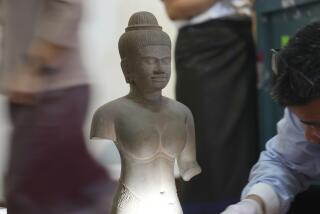YORBA LINDA : Cambodian Art Shown at Library
- Share via
A collection of rare Cambodian silver and pottery given to Richard M. Nixon during his days in the White House was put on display for the first time Monday at the former President’s library.
Cambodia’s president during the Nixon Administration, Heng Cheng, unveiled the display in a ceremony that included Cambodian music and a blessing from a group of Buddhist monks who fled their native country and now reside in Southern California.
“For many people here, Cambodia for the last 30 years has been perceived mostly as a focus of war,” said museum director John H. Taylor. “Because of the brutality of the Communist Khmer Rouge, many of the country’s cultural and artistic aspects might have been neglected because of the glare of the headlines.”
The exhibit, which runs through Oct. 27, includes gifts given to Nixon on a tour of Southeast Asia in 1953 and during his presidency, along with objects loaned to the library by private collectors of Cambodian art, curator Amanda Fish said. Many of the pieces have never been seen outside of Cambodia, Fish added.
The pieces include ornate Khmer silver works fashioned for the Norodom royal family, 12th-Century pottery, hand-loomed textiles and an 11th-Century Khmer stone deity torso. The three cases of art are accompanied by photographs and maps of the country, along with text to relate the exhibit to Cambodia’s history.
The Khmer Rouge took control of Cambodia in 1975 and set the populace to work clearing the country’s jungles and forests. Through executions and forced labor, the Khmer Rouge regime under Pol Pot is reported to have killed more than one million people during a period chronicled in a book entitled “The Killing Fields” and a movie by the same name.
Rakketak Dammo Kong Sophan, one of the Buddhist monks attending the Monday ceremonies, said the blessing he gave the exhibition’s debut was for Americans to understand his native land’s plight.
“The blessing was for the U.S. government and the U.S. people, and for them both to realize the suffering and pain of Cambodia,” he said through an interpreter. “The blessing was for peace and posterity in Cambodia, where these beautiful arts came from.”
More to Read
Sign up for Essential California
The most important California stories and recommendations in your inbox every morning.
You may occasionally receive promotional content from the Los Angeles Times.













